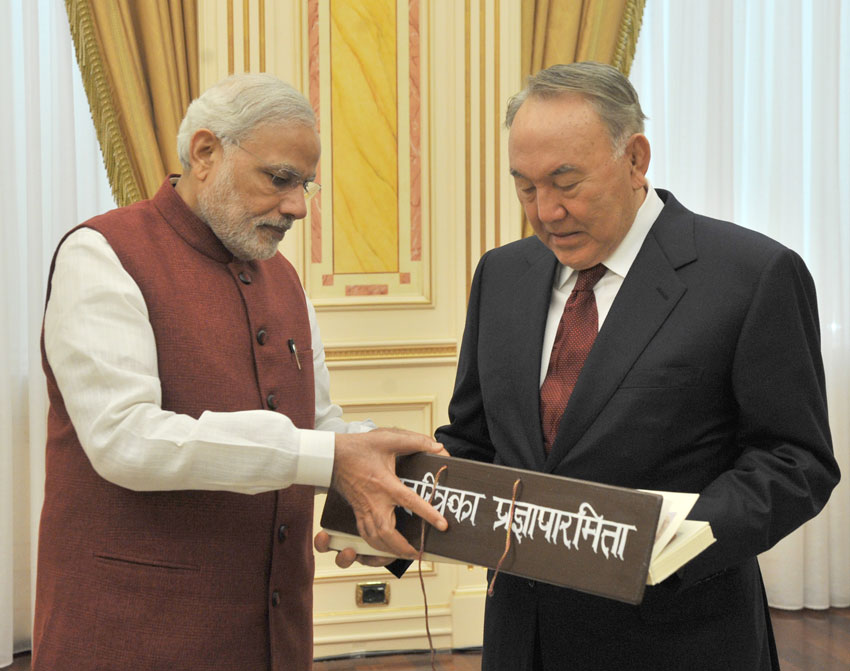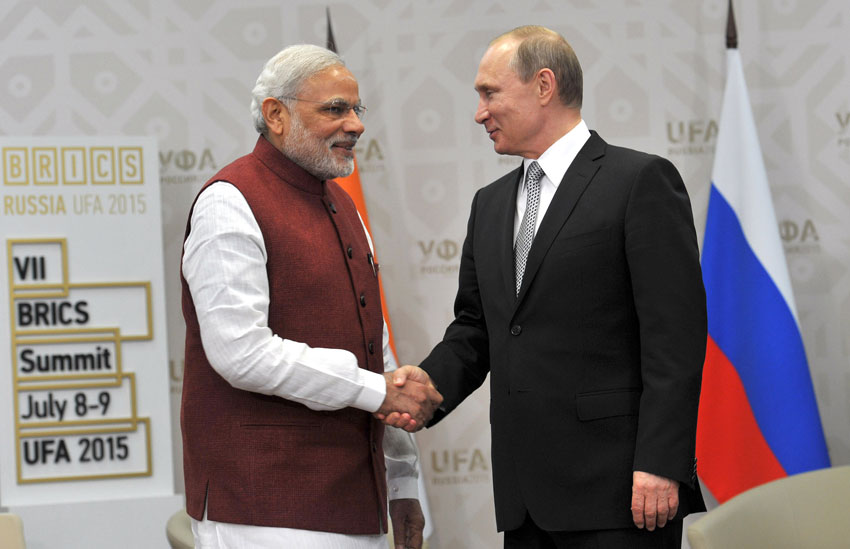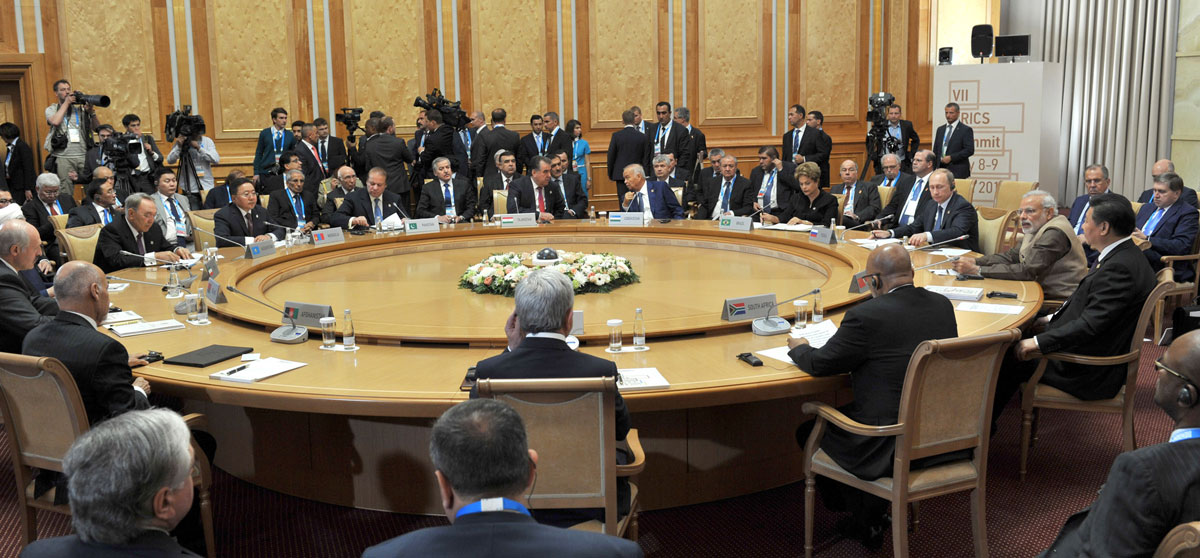STRATEGIC ALLIANCES
Prime Minister Narendra Modi at the meeting of BRICS Leaders with the Leaders of the invited states, in Ufa, Russia, July 9. (Press Information Bureau)
The world knows that Prime Minister Narendra Modi likes to travel overseas. Keeping up with the scorching pace that he has set, Modi recently visited five Central Asian nations and Russia, writes Siddharth Srivastava.
In Central Asia, the official talks focused on two key aspects, among other strategic factors: tapping the rich hydrocarbon resources of the region and increasing connectivity by setting up corridors via the land or sea route to enhance trade in commodities and transport of oil and gas. Russia has been making strategic moves to deepen engagement with India, including in defense and hydrocarbons, given its problems with western powers over the Ukraine conflict. Moscow was instrumental in the inclusion of India as member of the Shanghai Cooperation Organization earlier this month.

Modi in Central Asia
Though the talks between Modi and the various Central Asian leaders did not culminate in any significant agreements, they did highlight the importance the two sides attach to each other. “We see an important place for Central Asia in India’s future,” Modi said in Kyrgyzstan’s capital Bishkek. The Central Asian countries, meanwhile, have been keen to dilute the overbearing role of Russia and China in their economies and diversify engagement with newer emerging markets such as India.
Modi clearly spelled out newer opportunities emerging due to the nuclear deal signed between Iran and the world powers. In Turkmenistan, Modi said Ashgabat will be the first capital that India could access in Central Asia via Iran. “Together with the Kazakhstan-Turkmenistan-Iran rail link, and India’s proposed investment in Chahbahar Port in Iran, these initiatives will strengthen connectivity between our countries.”
Modi also hinted at linking lack of progress of the TAPI gas pipeline due to security and safety issues and gradual easing of sanctions on Iran. “The possibility of land-sea route through Iran for the pipeline should be explored,” Modi said indicating that Turkmenistan-Iran-India (TII) pipeline could be a possibility.
A joint statement issued following meetings between Modi and Turkmenistan President Gurbanguly Berdymukhammedov, however, termed the TAPI project a “key pillar” of economic engagement between the two countries.
The statement reaffirmed strong commitment towards timely implementation of the project including selection of consortium leader by September 1, 2015. “I convey our interest in long-term investment in the energy sector in Turkmenistan,” Modi said, while welcoming the decision of ONGC Videsh, the overseas arm of India’s flagship state-owned explorer ONGC, to open an office in Ashgabat. “We had a very positive discussion on India’s interest in investment in downstream industries, including petrochemicals and fertilizer,” Modi added.
In Kazakhstan, Modi said India wanted to invest in additional energy blocks, though no specific announcements were made. Modi said Kazakh President Nursultan Nazarbayev has “responded positively to my request to consider additional mature blocks.” Presently, ONGC Videsh owns a minor stake in Kazakhstan’s Satpayev oil blocks. The Indian entity failed to buy stake in Kashagan oilfield from ConocoPhillips in July 2013. India plans to conduct a feasibility study to import crude oil and gas from Kazakhstan through a pipeline or as LNG in ships.

Modi in Russia
There were more concrete gains to report from Russia. Moscow has proposed a plan to co-opt India in building Russian-designed nuclear power plants (NPP’s) in third countries. The cooperation would include joint extraction of natural uranium, production of nuclear fuel and atomic waste elimination.
Indian entities, private and state-owned, could form ventures with Rosatom, the state-owned Russian nuclear utility, that is involved in building NPP’s in more than a dozen countries, including Jordan, Hungary, Egypt, Iran, Finland, Turkey and Argentina. Russia has also proposed to build over 20 NPP’s in India, up from the 12 offered earlier.
The offer was made when Modi met Russian President Vladimir Putin at Ufa, ahead of the BRICS Summit in the central Russian City. The new proposals are expected to lay the foundation for “long-term, mutually beneficial cooperation in the nuclear sector (between India and Russia),” an official involved in delegation-level talks was quoted by news daily Indian Express. Quoting an unnamed government source, Russia & India Report (RIR) too confirmed that such negotiations did take place. The official said the offer could lead to “joint construction of power stations and other aspects of cooperation, including the training of personnel in other Asian countries, including Bangladesh, Vietnam, and Sri Lanka.”
“Cooperation in the field of nuclear energy was one of the main topics in talks between Modi and Putin,” the official added. The new proposals builds on agreements signed between Russia and India during Putin’s visit to New Delhi in December 2014, that re-defined plans for co-operation in peaceful use of nuclear power and building at least 12 NPP’s in India. Russia is helping India build the Kudankulam NPP, the first 1,000 MW unit of which was connected to national grid in 2013.


